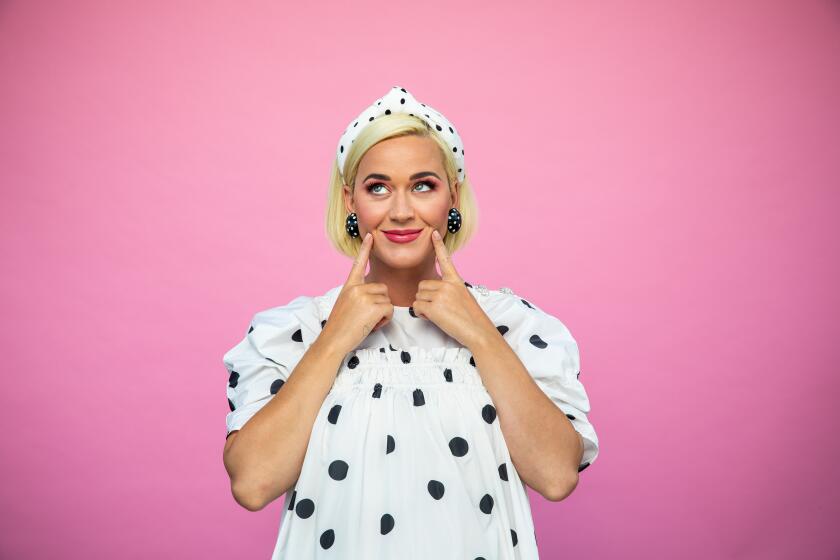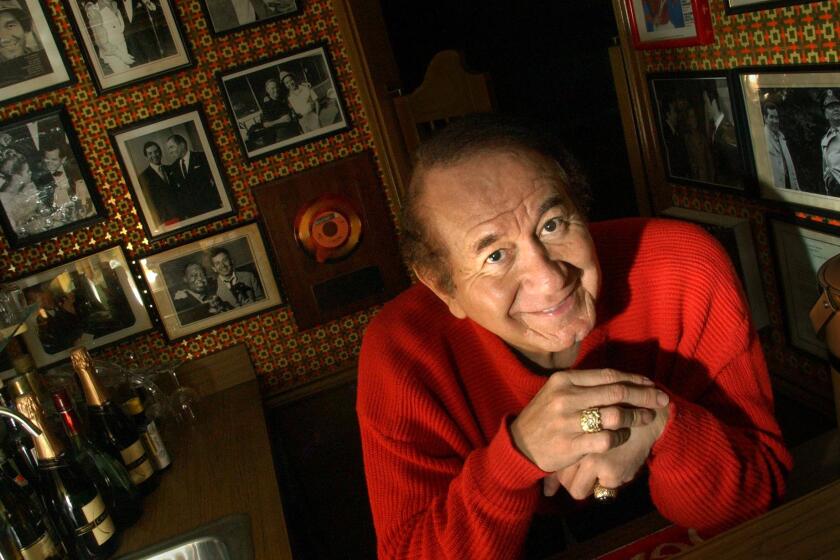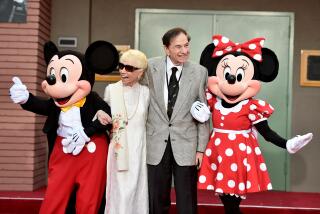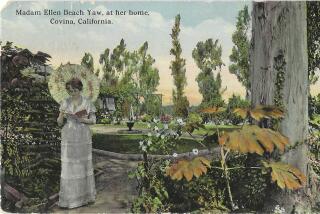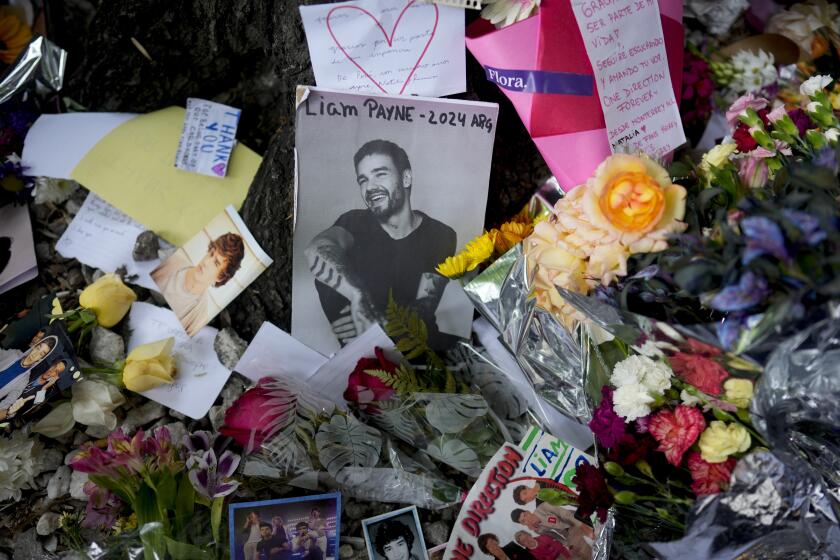A collector says he discovered two never-before-heard Sinatra recordings. But is it really Frank?
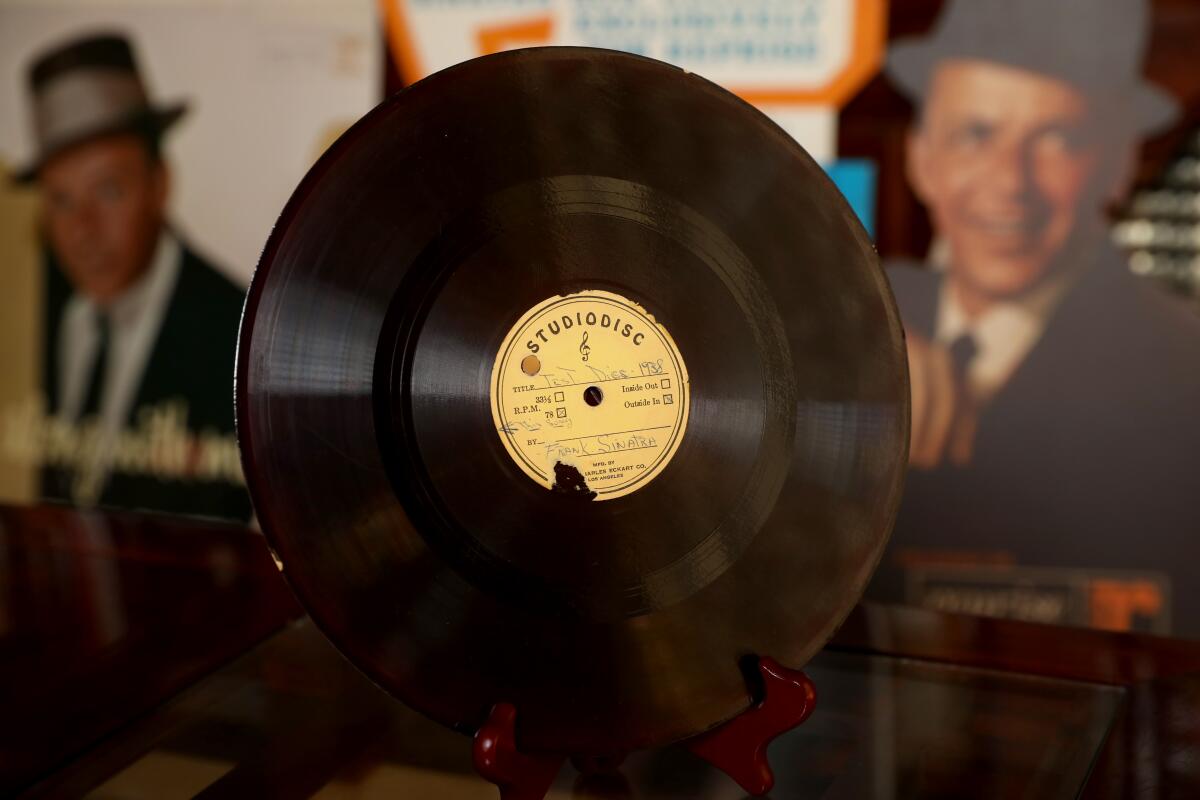
- Share via
A few years after Jim Mahoney purchased one of the world’s most complete collections of Frank Sinatra music and memorabilia at auction, he finally got around to the boxes containing 78-rpm records and 10-inch acetates.
Mahoney, 59, had picked up the 150 containers filled with thousands of recordings and documents in 2017, but since then he’d been focused on the 1,000-plus Sinatra LPs and 450-odd 45-rpm singles. When the pandemic hit, he began whiling away the hours at his home in Oakland by sifting through boxes of 78s, the format popular in the 1940s during Sinatra’s earliest professional years.
That’s when he first pulled out an acetate record — a disc akin to a proof in photography — with Sinatra’s name scribbled on it. It contained four songs. “I put it on my turntable and was really surprised to hear Frank Sinatra singing a cappella,” says Mahoney, who has collected Sinatra’s work for 40 years. It was a song called “Let the Rest of the World Go By,” written in 1919. Willie Nelson and Leon Russell had a modest hit with it in 1979.
After further research, Mahoney was even more stumped. The B-side had another Sinatra a cappella, a rendition of Irish songwriter Jimmy Kennedy’s “An Hour Never Passes.” Each side also featured scratchy recordings of Sinatra singing with a band — “My Melancholy Baby” and another song too hissy to be identified.
Neither of the two unaccompanied vocal tracks had ever been logged as existing; Sinatra never sang either of the songs in public. Searching for clarification, Mahoney reached out to longtime Sinatra archivist and collector Ric Ross. The disc, and the entire collection, used to be his.
Ross had been among the world’s foremost Sinatra archivists since the 1960s. “I’m certain that Ric Ross knows more about me than I do myself,” Sinatra himself told The Times in a 1988 story headlined “Chairman of the Archives.” Ross, now 82, was such an authority on the iconic crooner’s life and work that the Chairman himself would query the collector on elements of his own history and discography.
After fighting through what her friend Sia calls a “real breakdown,” a resilient Katy Perry is set to deliver her first child and a new album, “Smile.”
Twenty years ago, Ross’ holdings had been appraised at more than $500,000. But time has not been kind to the Sinatra collectors’ market. Mahoney’s winning bid for the entire lot was $12,000.
Mahoney now believes that he got an unadvertised bonus: an acetate that contains the only two unlogged Sinatra recordings in existence. “It is very unusual that two recordings of this type would have escaped for so long,” he says. “And I think it just got buried in his archives. Once he shelved it, it never saw the light of day.”
But as with many unearthed, undocumented recordings, their authenticity has become a Rorschach test among experts — even when the artist in question possessed one of the 20th century’s most iconic and identifiable voices.
“Not even close. It’s not Frank’s tone. It’s not Frank’s way of singing,” says vocal coach Gary Catona, who has worked with singers including Barbra Streisand, Pharrell Williams, Michael McDonald and Sade. Catona has studied and written extensively about Sinatra’s “cello-like vocal tone.”
“I’m 100% convinced it’s Sinatra,” Mahoney asserts. “There’s nobody with his style — his elongated phrasing, the timbre.”
Ross agrees, with a caveat: “I’ve listened to a lot of radio shows and recordings during the time that these recordings were supposedly made. It’d be tough to say I’m 100% certain, but it certainly sounds a lot like the 1944 Sinatra I’m used to listening to.”
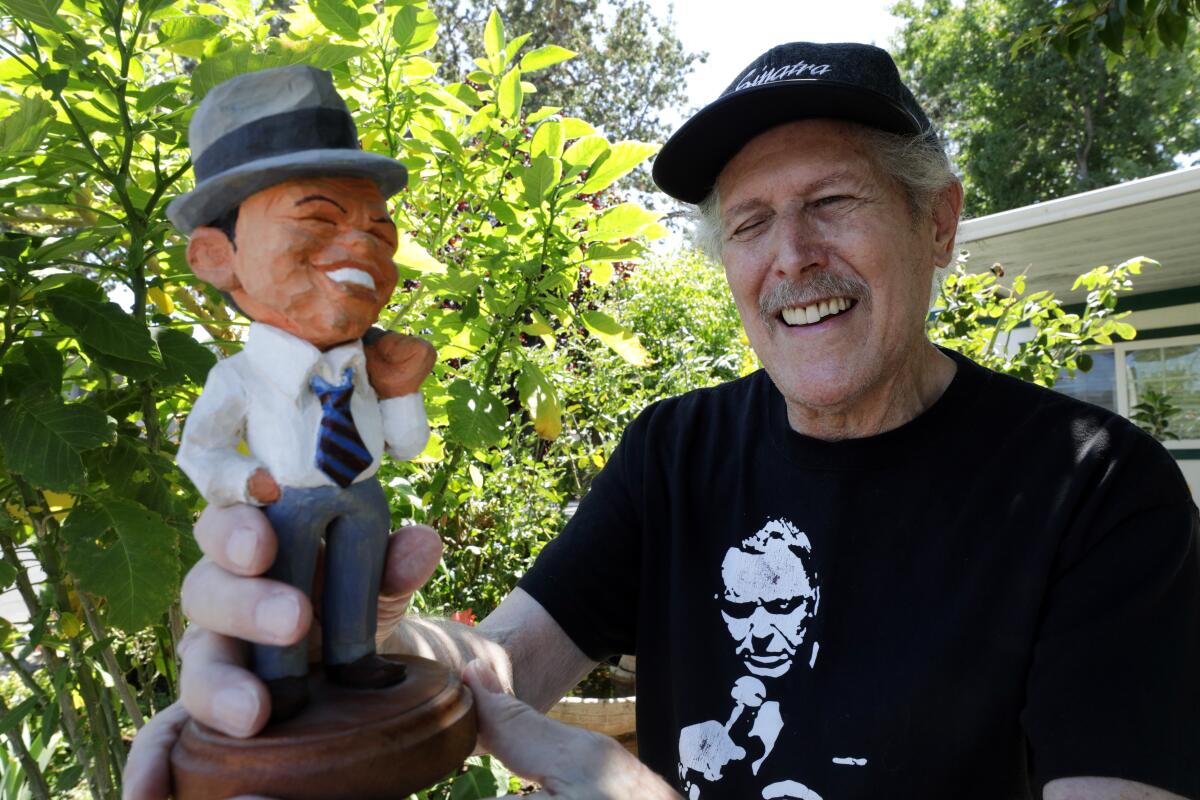
Over a lifetime of Sinatra fandom, Ross spent tens of thousands of dollars, and just as many hours, on his archive. In the 1960s he worked in marketing and business management and established friendships with Sinatra‘s business and legal representatives, as well as with music publishers and music directors.
“I gained a tremendous benefit in knowing these people,” Ross says on the phone from his home in Thousand Oaks.
He snagged tapes of Sinatra’s first-ever Hollywood Bowl performance in 1943, for example, after reaching out to the conductor who led the orchestra that night.
His was an unpaid obsession, but soon Ross had established himself. If Sinatra or his people needed old session or discography details, they called Ross. In exchange, someone in Sinatra’s camp — often his longtime publishing agent Sarge Weiss — would give him rarities for safekeeping.
“Sarge Weiss and Sinatra were basically brothers for 40-something years,” says Chuck Granata, author, Sinatra reissue producer and Sinatra estate advisor who does a SiriusXM show with Frank’s daughter, Nancy Sinatra.
Ross continued adding to his Sinatra holdings after the singer died in 1998. But as one century turned to the next, the once-towering icon’s legacy began fading as his fans aged and pop culture moved on.
Trini Lopez, a singer and guitarist who gained fame for his versions of “Lemon Tree” and “If I Had a Hammer” in the 1960s, has died.
Around the same time, Sinatra’s children Nancy, Frank Jr. and Tina began taking a hard-line stance against use of their father’s trademark. Believing that the collectors market was filled with dubiously sourced, possibly stolen work that was rightfully theirs, they threatened legal action against a number of high-profile collectors, including Ross, who became persona non grata with the tightknit Sinatra clan. (The Sinatra estate did not reply to requests for comment.)
In 2016, as he was relocating into a smaller home, Ross decided to sell his collection. Among the items were thousands of Sinatra releases, domestic and international — “virtually every significant recording made by Sinatra for the RCA, Columbia, Capitol, and Reprise labels,” according to the auction description. Bootlegs, reel-to-reel tapes filled with motion picture soundtracks, recording sessions, TV and radio appearances, sheet music and interviews. Ten half-inch, studio-grade tapes of session material. Sinatra’s cigarette lighters, watches, stage passes, photos, press clippings, card decks, matchbooks, mugs and plates; 3,000-4,000 hours of Sinatra interviews; session charts and studio notes; and a meticulously kept five-decade-long calendar of Sinatra’s day-to-day activities.
“I knew it was something worth bidding on,” Mahoney said.
Little did he know. Mahoney bid first. There was a pause. An unknown internet buyer upped the offer. “I countered,” says Mahoney, “and that was it.”
Not long after, Mahoney, a retired accountant, arrived at the auction house in a rental truck and workers loaded the haul into the back. He drove it all home and offloaded his winnings into his house.

In March of this year, as stay-at-home orders presented more time for exploration, Mahoney was digging through his stuff. Like most Sinatra collectors, he’s eligible for AARP membership and has followed the singer’s musical life for decades. His mind is stored with factoids, quickly accessible and seemingly organized as mental spreadsheets.
The disc that he held in his hands was 10 inches in diameter and had an aluminum core. Its circular center label was branded “Studiodisc.” Small print identified it as being manufactured by the Los Angeles-based Charles Eckart Co., which opened in 1940. Both sides of Mahoney’s record had “Test Disc — 1938” and “Frank Sinatra” written in ink, with the A-side also identifying one of the live songs, “Melancholy Baby.”
The first person Mahoney called to crack the code was Ross. Despite selling his trove at a huge loss, Ross was happy to answer questions about his former holdings.
“We’ve narrowed it down to the final quarter of 1944. Sinatra did mostly a cappella things for Columbia between ’43 and the end of ’44,” Ross says. “An Hour Never Passes” was published in mid-1944. That year, Sinatra was unable to record with his studio band, as a strike among musicians sidelined Columbia session players and vocalists. Lacking the ability to release records with instrumentation, Sinatra and others turned to vocal groups to provide harmonies and arrangements.
The singer spent half of 1944 in L.A. Already a heartthrob, not yet 30, he’d traveled from his home in New Jersey to booming Southern California to do some soundtrack recordings. At the time, Ross continues, the singer broadcast his “Frank Sinatra in Person” show for the CBS Radio network from Los Angeles.
Mahoney thinks the two radio tracks were recorded on Sept. 13, 1944, in front of a live audience for broadcast later in the day. He also thinks that on that same day, Sinatra casually tossed off a couple of solo, unaccompanied takes.
On a Zoom call with Mahoney and The Times, Sinatra expert Granata said that he has little doubt that the recording with musical accompaniment is Frank in L.A. with his CBS Radio band. “That is Frank,” Granata said after Mahoney played him a snippet from “My Melancholy Baby.”
Among the most respected Sinatra collectors, Granata penned the book “Sessions With Sinatra: Frank Sinatra and the Art of Recording,” considered the definitive source on Sinatra in the studio. He produces Columbia’s Sinatra holdings. As far as Granata is aware, Sinatra never laid the two a cappella songs to tape.
He called the notion of a recording existing of Sinatra singing minus accompaniment at that moment in his career “very interesting. Could it be a recording someone close to Frank made? Very possibly.” He cites as an example a recently uncovered home-cut recording that Sinatra made during a 1943 visit back to New Jersey during the holiday season. Accompanied by a friend playing the organ, Sinatra sang a couple of songs that the friend recorded.
Mahoney cued up the Sinatra a cappella take on “Let the Rest of the World Go By.”
The disc is a little crackly, but strikingly clear. The song opens with a solitary, baritone voice, and the lack of acoustic echo suggests whoever’s behind it is recording in a small room. The singer indeed sounds like Sinatra. He’s patient and relaxed, at ease within the love song, which imagines an idyllic life in warm solitude. “We’ll find perfect peace where joys never cease / Out beneath the Western skies,” he croons with a touch of vibrato, varying a little from the original lyrics. “We’ll build a little nest somewhere in the West / And let the rest of the world go by.”
The second side features the same singer doing another solo recording, of “An Hour Never Passes.” To an untrained ear, at least, this too sounds like Sinatra. As the record concluded, Mahoney picked up the needle.
Granata’s verdict arrived quickly: “Having worked with hundreds, if not thousands, of his radio and commercial Columbia and Victor recordings, I just don’t feel that those two a cappella recordings are Frank.” He added, “It definitely does have some of the Sinatra characteristics, but there’s a little nasality in there, and it’s when the singer becomes nasal that I start to hear that it’s not Frank.”
Mahoney countered, eager to grill a fellow authority: “You say it’s close. But if it’s close, who else could it be? A singer that sounds like Sinatra that we never heard from again?” Mahoney then cited “the strong circumstantial evidence — his name is on the disc and you’ve got two radio tracks on the disc. I think it’s more than close.”
“I can’t even hazard a guess as to who it could be,” Granata replied.
He added that, after sharing a clip with Great American Songbook revivalist and scholar Michael Feinstein, he has no doubt it ain’t the Chairman: “I’m 100% confident in what Michael and I think.”

Despite the record turning up in a noted Sinatra collector’s holdings, the many variables render its provenance questionable, Granata had explained in an earlier conversation. Just because Sinatra buddy Weiss gave it to Ross doesn’t mean it contains the Chairman’s voice. For example, Granata said, “It’s entirely possible that [Weiss] could have had a singer that sounded like Sinatra cut a demo for Frank, and then he played it for Frank.” Or, he added, maybe a studio engineer at some later point came across a few different records and dubbed them onto a Soundisc blank.
“I may be wrong. I’m not infallible,” said Granata. But he emphasized that he had no agenda. “I wish I could say it was Frank’s voice.”
Longtime Sinatra expert and professional singer Peter Oprisko has heard the recordings and agrees that “the tone of the voice is very similar,” and says via email “that the pronunciation on certain words seems a bit skewed/sloppy.” Oprisko says that’s Sinatra’s New Jersey accent seeping in. He posits that Mahoney’s record could be a rough run-through, minus any engineering tweaks.
“We know that Sinatra often did not go all-out during his rehearsals,” he says, adding that it’s possible Sinatra was experimenting or rehearsing. “There are simply too many flaws to make it commercially viable. So I’m willing to say this is Sinatra, but not at his best.”
Mahoney has reached out to both the Sinatra estate and to Sony Music, which owns Columbia Records. His hope is to license the recording to Sony for a collection. Asked whether Columbia is aware of Mahoney’s acetate, Tom Tierney, head archivist at Sony Music, said that he had spoken to the collector and put him in touch with the company’s A&R department.
Authentication in such a circumstance can be tricky. Sinatra himself, in fact, occasionally mistook someone else’s voice as his own. Famously, in 1946 he was playing poker with friends when a crooner came on the radio. Asked if the singer was him, Sinatra said it was — only to hear the DJ jump in and say, “And that was the voice of Vic Damone.’”
More to Read
The biggest entertainment stories
Get our big stories about Hollywood, film, television, music, arts, culture and more right in your inbox as soon as they publish.
You may occasionally receive promotional content from the Los Angeles Times.
